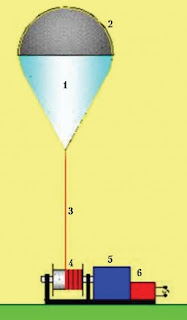Solar balloons to generate renewable energy
A significant limitation of today’s solar installations is their unstable operation dependent on the amount of solar energy reaching the earth surface, varying based on the weather conditions, season and time of day.
The development of power plants utilizing solar balloons can become a new direction in renewable energy usage, which will enable a more efficient use of solar energy. The main element of such a power plant, a solar balloon, can be raised a few kilometers over the ground, floating above the clouds, and provide sustainable utilization of solar energy throughout the day.
In a stratosphere PV power plant, the two-layer PV surface of the installation absorbs solar energy, the thermal power of which causes the steam inside to heat. The light going through the outer transparent layer heats the interior layer; as a result, the steam inside heats to 100-150°С. The two layers are divided with gas or air serving as thermal insulation that reduces thermal loss to the atmosphere. The steam pressure is close to that of the air outside the stratosphere installation.
The water steam, through a flexible steam pipe, goes to the steam turbine and condenses in the condenser. The water is again supplied out of the condenser to the internal cavity of the sheath, where it evaporates due to contact with heated water steam. Such an installation can have an efficiency of up to 25%; in addition, using the water steam stored in the internal cavity, a stratosphere installation can operate at night. A 150-meter in diameter solar power balloon placed at an altitude of 5 km can have a capacity of 2 MW.
Stratosphere PV installation
1 – sheath of solar balloon2 – thin-film solar cell
3 – string with a cable
4 – cable drum
5 – electric motor
7 – reductor
6 – inverter
Such a stratosphere PV power station can be placed hundreds of meters above the ground with a steam-turbine unit on the ground, or above the sea surface with the power unit located on anchored platforms fixing the stratosphere installation. The operation of a 5-7 km high stratosphere power plant does not depend on weather conditions, and the steam turbine unit can be placed either on the ground or in the basket of the solar balloon. In the latter case electricity is transmitted to the ground along a cable. Currently, such solar balloons are used in Taiwan.
The first experimental solar PV power plant, launched in 2003, consists of a solar energy receiver made up of several layers of flexible spherical sheaths. An important benefit of the installation is the fact that the steam condensed by the condenser into the separated compartments of the space between the transparent and absorbing layers circulates on the lit side only. This 2 MW stratosphere PV installation occupies an area of 0.3 km2. In another solar installation, launched in 2005, the centre of the 300 m in diameter sheath is at an altitude of 450 m, which made it possible to substantially reduce the occupied area. Having a positive experience of exploiting such stratosphere PV stations, Taiwan intends to use them on a wider scale.
Space-based solar power plants
Another important direction in the development of solar energy exploitation is the creation of orbital solar power plants with solar arrays accumulating the energy of the Sun and converting it into microwave or laser emission directed at the Earth, where it is received with designated antennas and then converted to electrical energy.
For the purpose of converting solar energy into electricity, the industry uses solar cells, which, combined together, make up solar arrays.
In space, where there is no atmosphere, clouds, the change of day to night, the amount of solar energy is ten times as much as that on the ground. Research into the development of orbital solar power stations began in 1970s in the USA, USSR and other countries.
Currently, orbital solar power stations are being developed in the USA, Russia, Japan and other countries. This work utilizes the latest technological developments in photovoltaics, electronics, and robotics. More research is required on the ways to reduce the weight and cost of orbital power stations.
Around 2030, Japan intends to assemble an orbital solar power station at an altitude of 36 thousand kilometers, which is to transmit electricity to earth as a microwave beam, to be received by an Earth station antenna. The Japanese scientists have developed solar cells converting solar radiation into a laser beam with an efficiency of 42 %.
Source (Russian language): http://energetika.in.ua
Alexei Tiatiushkin
Marketing manager
KharkovEnergoPribor Ltd.
marketing@keppowertesting.uk
http://www.kep.ua



Comments
Post a Comment